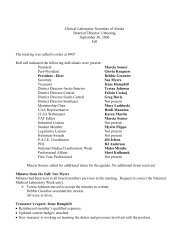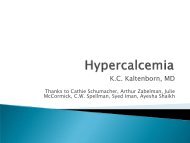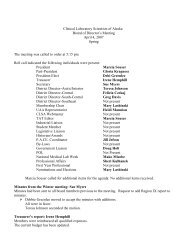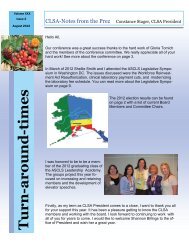The Use of NT-proBNP and BNP as Biomarkers of Acute Heart Failure
The Use of NT-proBNP and BNP as Biomarkers of Acute Heart Failure
The Use of NT-proBNP and BNP as Biomarkers of Acute Heart Failure
You also want an ePaper? Increase the reach of your titles
YUMPU automatically turns print PDFs into web optimized ePapers that Google loves.
<strong>The</strong> <strong>Use</strong> <strong>of</strong> <strong>NT</strong>-<strong>pro<strong>BNP</strong></strong> <strong>and</strong> <strong>BNP</strong> <strong>as</strong><br />
<strong>Biomarkers</strong> <strong>of</strong> <strong>Acute</strong> <strong>Heart</strong> <strong>Failure</strong><br />
John Backus, Ph.D.<br />
Director, Scientific Affairs<br />
© Ortho-Clinical Diagnostics, Inc.
Presentation Outline<br />
•B-Type Natriuretic Peptides <strong>BNP</strong> & <strong>NT</strong>-<strong>pro<strong>BNP</strong></strong><br />
•B-type Natriuretic Peptide Biology<br />
•<strong>Use</strong> <strong>of</strong> <strong>BNP</strong> in the <strong>Acute</strong> Setting<br />
•Potential benefits <strong>of</strong> <strong>NT</strong>-<strong>pro<strong>BNP</strong></strong><br />
•Non-HF Sources <strong>of</strong> Elevated <strong>NT</strong>-<strong>pro<strong>BNP</strong></strong> (<strong>and</strong> <strong>BNP</strong>)<br />
•<strong>Use</strong> <strong>of</strong> <strong>NT</strong>-<strong>pro<strong>BNP</strong></strong> in the <strong>Acute</strong> Setting<br />
•Other Clinical Utilities <strong>of</strong> <strong>NT</strong>-<strong>pro<strong>BNP</strong></strong><br />
© Ortho-Clinical Diagnostics, Inc.
B-type Natriuretic Peptides<br />
Pre-Pro-<strong>BNP</strong> 1-134<br />
26-aa signal<br />
sequence<br />
Pro-<strong>BNP</strong> 1-108<br />
WALL<br />
STRESS<br />
N-terminal<br />
Pro-<strong>BNP</strong> 1-76<br />
t 1/2 = 60-120 min<br />
<strong>BNP</strong> 77-108<br />
t 1/2 = 18 min<br />
Source: Medscape.com (10/12/2009)<br />
3
<strong>Use</strong> <strong>of</strong> <strong>BNP</strong> Assay<br />
• “…useful in establishing or excluding the diagnosis <strong>of</strong><br />
CHF in patients with acute dyspnea.”<br />
• 100 pg/ml cut<strong>of</strong>f (for ruling out)<br />
• 90 % sensitivity<br />
• 76% specificity<br />
• 89% NPV<br />
• <strong>BNP</strong> > 500 pg/ml PPV=90%<br />
• Grey zone 100pg/ml-500pg/ml where there are a<br />
number <strong>of</strong> conditions that could cause incre<strong>as</strong>ed levels<br />
Source: Maisel et al, New Eng J Med (2002) 347:161-167.<br />
4
“Breathing Not Properly” Multinational Study<br />
Source: Maisel et al, New Eng J Med (2002) 347:161-167.<br />
5
B-Type Natriuretic Peptide<br />
“…<strong>BNP</strong> concentrations are higher in females <strong>and</strong><br />
incre<strong>as</strong>e with incre<strong>as</strong>ing age…Given that HF is,<br />
to a large extent, a dise<strong>as</strong>e <strong>of</strong> the aging <strong>and</strong> that<br />
the prevalence <strong>of</strong> HF in younger groups is low<br />
compared with age groups >55, it is likely that<br />
the use <strong>of</strong> age- <strong>and</strong> gender-related cut<strong>of</strong>fs will<br />
improve the clinical sensivity <strong>of</strong> all <strong>BNP</strong> <strong>as</strong>says<br />
while maintaining a high specificity.”<br />
Source: Wu et. Al, Clin Chem (2004) 50:867-873.<br />
6
ValHeft Study: 2006<br />
LVEF: left ventricular ejection fraction<br />
LVIDd: left ventricular diameter in di<strong>as</strong>tole<br />
Source: M<strong>as</strong>son et al, Clin Chem (2006) 52:1528-1538.<br />
7
An <strong>NT</strong>-<strong>pro<strong>BNP</strong></strong> cut-point <strong>of</strong> 900 pg/mL Performs<br />
Similarly to a <strong>BNP</strong> cut-point <strong>of</strong> 100 pg/mL<br />
PRIDE (<strong>NT</strong>-<strong>pro<strong>BNP</strong></strong>)<br />
Breathing Not Properly (<strong>BNP</strong>)<br />
Sources: Januzzi et al, Eur <strong>Heart</strong> J (2006) 27: 839-845.<br />
Maisel et al, New Eng J Med (2002) 347:161-167.<br />
8
<strong>NT</strong>-<strong>pro<strong>BNP</strong></strong> Levels by Diagnosis<br />
in Patients with <strong>Acute</strong> Dyspnea<br />
Source: Januzzi et al, - Eur <strong>Heart</strong> J (2006) 27: 330-337.<br />
9
Why <strong>NT</strong>-<strong>pro<strong>BNP</strong></strong><br />
I. <strong>NT</strong>-<strong>pro<strong>BNP</strong></strong> is more stable than <strong>BNP</strong>*<br />
Mean recovery <strong>of</strong> <strong>BNP</strong> w<strong>as</strong> less than 70% after one day <strong>of</strong> storage at –20°C <strong>and</strong><br />
decre<strong>as</strong>ed to less than 50% after two to four months <strong>of</strong> storage<br />
II.<br />
III.<br />
IV.<br />
<strong>NT</strong>-<strong>pro<strong>BNP</strong></strong> values are generally more precise**<br />
<strong>NT</strong>-<strong>pro<strong>BNP</strong></strong> <strong>as</strong>says have shown excellent within run <strong>and</strong> total precision with total CV<br />
ranging from 2.9% to 6.1%. In contr<strong>as</strong>t, total CV for <strong>BNP</strong> ranged from 9.9% to 12.5%,<br />
which is approximately 2-3 fold higher than the <strong>NT</strong>-<strong>pro<strong>BNP</strong></strong> method.<br />
<strong>NT</strong>-<strong>pro<strong>BNP</strong></strong> is a better predictor <strong>of</strong> patient outcomes***<br />
<strong>NT</strong>-<strong>pro<strong>BNP</strong></strong> w<strong>as</strong> superior to <strong>BNP</strong> for predicting mortality <strong>and</strong> morbidity (P=0.032) or<br />
hospitalization for HF (P=0.0143)<br />
<strong>NT</strong>-<strong>pro<strong>BNP</strong></strong> <strong>as</strong>says are harmonized****<br />
Common source <strong>of</strong> antibodies (Roche)<br />
Age-related cut <strong>of</strong>f values established<br />
Sources: * Mueller et al, Clin Chem Lab Med (2004) 42:942-944.<br />
** Yeo et al, Clin Chim Acta (2003) 338:107-15.<br />
*** M<strong>as</strong>son et al, Clin Chem (2006) 52:1528-38 .<br />
**** Januzzi et al, Am J Cardiol (2008) 101: 9A-15A.<br />
10
VITROS ® <strong>NT</strong>-<strong>pro<strong>BNP</strong></strong> – Method Comparison<br />
<strong>NT</strong>-<strong>pro<strong>BNP</strong></strong><br />
– Adopted in Clinical Practice Guidelines<br />
– Optimal accuracy <strong>and</strong> precision<br />
– Method Comparison: Demonstrates<br />
excellent agreement across me<strong>as</strong>uring<br />
range<br />
Source : Pub. No. GEM1315_EN_US Version 4.0<br />
Trademarks not owned by Ortho Clinical Diagnostics<br />
are the property <strong>of</strong> their respective owners<br />
11
Potential Causes <strong>of</strong> <strong>NT</strong>-<strong>pro<strong>BNP</strong></strong> Elevation<br />
Source:<br />
Januzzi et al, - Am J Cardiol (2008) 101: 29A-38A.<br />
12
<strong>NT</strong>-<strong>pro<strong>BNP</strong></strong> in the <strong>Acute</strong> Setting<br />
13
ICON Study Group:<br />
James Januzzi, Aaron Baggish (Boston)<br />
Antoni Bayes-Genis (Barcelona)<br />
Rol<strong>and</strong> RJ van Kimmenade, Yigal Pinto (Ma<strong>as</strong>tricht)<br />
A. Mark Richards, John Lainchbury (Christchurch)<br />
Source: Januzzi et al, Eur <strong>Heart</strong> J (2006) 27: 839-845.<br />
14
<strong>NT</strong>-<strong>pro<strong>BNP</strong></strong> Levels by Diagnosis<br />
in Patients with <strong>Acute</strong> Dyspnea<br />
Source: Januzzi et al, - Eur <strong>Heart</strong> J (2006) 27: 330-337.<br />
15
<strong>NT</strong>-<strong>pro<strong>BNP</strong></strong> Levels in <strong>Acute</strong> <strong>Heart</strong> <strong>Failure</strong><br />
<strong>as</strong> a Function <strong>of</strong> <strong>Heart</strong> <strong>Failure</strong> Severity<br />
Source: Januzzi et al, - Eur <strong>Heart</strong> J (2006) 27: 330-337.<br />
16
<strong>NT</strong>-<strong>pro<strong>BNP</strong></strong> Levels Predict Survival<br />
in Patients with <strong>Acute</strong> <strong>Heart</strong> <strong>Failure</strong><br />
Source: Januzzi et al, - Eur <strong>Heart</strong> J (2006) 27: 330-337.<br />
17
Elevated <strong>NT</strong>-<strong>pro<strong>BNP</strong></strong> <strong>and</strong> Impaired Renal<br />
Function Predict Poor Outcome in <strong>Acute</strong> HF<br />
Source:<br />
Baggish et al, - Am J Cardiol (2008) 101: 49A-55A.<br />
18
Age-independent Rule-out Cut-point<br />
• International Collaborative <strong>of</strong> <strong>NT</strong>-<strong>pro<strong>BNP</strong></strong> (ICON) Study data (acute setting):<br />
• 300 pg/ml, age independent<br />
• 99% sensitive<br />
• 60% specific<br />
• 98% NPV<br />
Source: Januzzi et al, Eur <strong>Heart</strong> J (2006) 27: 839-845.<br />
19
Age-stratified Rule-in Cut-points<br />
• International Collaborative <strong>of</strong> <strong>NT</strong>-<strong>pro<strong>BNP</strong></strong> (ICON) Study data (acute setting):<br />
To Diagnose <strong>Acute</strong> <strong>Heart</strong> <strong>Failure</strong><br />
Age strata<br />
All 75 years<br />
1800 pg/ml<br />
85%<br />
73%<br />
92%<br />
55%<br />
83%<br />
*Very superior to single cut-point strategy in multivariable bootstrapping models<br />
Source: Januzzi et al, Eur <strong>Heart</strong> J (2006) 27: 839-845.<br />
20
<strong>NT</strong>-<strong>pro<strong>BNP</strong></strong> vs <strong>BNP</strong> for <strong>Acute</strong> <strong>Heart</strong> <strong>Failure</strong><br />
General Summary<br />
• Individuals with heart failure typically have approximately 8-10X higher<br />
levels <strong>of</strong> <strong>NT</strong>-<strong>pro<strong>BNP</strong></strong> versus <strong>BNP</strong>.<br />
• Close to half <strong>of</strong> this difference is due to the difference in molecular weight <strong>of</strong> the two molecules<br />
(<strong>NT</strong>-<strong>pro<strong>BNP</strong></strong> is about 2.5X larger than <strong>BNP</strong>).<br />
• <strong>The</strong> rest is likely due to the fact that <strong>NT</strong>-<strong>pro<strong>BNP</strong></strong> h<strong>as</strong> higher in vivo stability.<br />
• As an aid in the diagnosis <strong>of</strong> acute heart failure, a single <strong>NT</strong>-<strong>pro<strong>BNP</strong></strong><br />
cut-point <strong>of</strong> 900 pg/mL <strong>of</strong>fers performance essentially equivalent to a<br />
<strong>BNP</strong> cut-point <strong>of</strong> 100 pg/mL.<br />
• <strong>The</strong> ICON triple “rule-in” <strong>NT</strong>-<strong>pro<strong>BNP</strong></strong> cutpoints for acute heart failure<br />
(age-specific cutpoints <strong>of</strong> 450, 900, <strong>and</strong> 1800 pg/mL) are designed to<br />
account for the impacts <strong>of</strong> age <strong>and</strong> renal function<br />
• Both <strong>BNP</strong> <strong>and</strong> <strong>NT</strong>-<strong>pro<strong>BNP</strong></strong> incre<strong>as</strong>e with incre<strong>as</strong>ing age <strong>and</strong> decre<strong>as</strong>ing renal function.<br />
• <strong>The</strong> ICON triple <strong>NT</strong>-<strong>pro<strong>BNP</strong></strong> cutpoints are designed to provide similar information, but with better<br />
performance, relative to the <strong>BNP</strong> cut-point <strong>of</strong> 100 pg/mL.<br />
• Relative to <strong>BNP</strong>, <strong>NT</strong>-<strong>pro<strong>BNP</strong></strong> also <strong>of</strong>fers the benefits <strong>of</strong> platform<br />
harmonization <strong>and</strong> enhanced analyte stability, both in vitro <strong>and</strong> in vivo<br />
Source:<br />
Januzzi et al. Am. J. Cardiol 2008; 101: 29A-38A.<br />
21
Other Clinical Utilities <strong>of</strong> <strong>NT</strong>-<strong>pro<strong>BNP</strong></strong><br />
22
VITROS ® <strong>NT</strong>-<strong>pro<strong>BNP</strong></strong> – Intended <strong>Use</strong><br />
Source : Pub. No. GEM1315_EN_US Version 4.0<br />
© Ortho-Clinical Diagnostics, Inc.<br />
23
<strong>NT</strong>-<strong>pro<strong>BNP</strong></strong> Decision Thresholds<br />
Defined in Individuals With No <strong>Acute</strong> Symptoms<br />
Source : Pub. No. GEM1315_EN_US Version 4.0<br />
© Ortho-Clinical Diagnostics, Inc.<br />
24
<strong>NT</strong>-<strong>pro<strong>BNP</strong></strong>-Tailored CHF <strong>The</strong>rapy<br />
<strong>The</strong> PROTECT Trial <strong>as</strong> an Example<br />
Source:<br />
Bhardwaj et al. Am <strong>Heart</strong> J 2010;159: 532-538.e1.<br />
25
Inclusion/Exclusion Criteria<br />
Inclusion Criteria<br />
• Age > 21 years <strong>of</strong> age<br />
• Left ventricular ejection fraction ≤ 40%<br />
• New York <strong>Heart</strong> Association cl<strong>as</strong>s II-IV symptoms<br />
• Hospitalization, ED visit, or outpatient therapy for ADHF within 6 months<br />
Exclusion criteria<br />
• Serum creatinine > 2.5 mg/dl<br />
• Inoperable aortic valve dise<strong>as</strong>e<br />
• Life expectancy
Study Endpoints<br />
•1 endpoint<br />
•Total cardiov<strong>as</strong>cular<br />
events*<br />
• Worsening HF †<br />
• HF hospitalization<br />
• ACS<br />
• Ventricular arrhythmia<br />
• Cerebral ischemia<br />
• Cardiov<strong>as</strong>cular death<br />
•2 endpoints<br />
•Quality <strong>of</strong> life<br />
•Changes in echo<br />
parameters<br />
• LV ejection fraction<br />
• LVESVi<br />
• LVEDVi<br />
*Assessed using generalized estimating equations<br />
†<br />
Requiring at le<strong>as</strong>t 2 from the following: symptoms <strong>of</strong> congestion or falling cardiac output,<br />
signs <strong>of</strong> new congestion on exam, use <strong>of</strong> “bail out” decongestive therapy, or rising <strong>NT</strong>-<strong>pro<strong>BNP</strong></strong><br />
in the un-blinded arm<br />
Source: Januzzi et al. clinicaltrialresults.org/Slides/PROTECT%20Presentation%20FINAL.ppt, accessed March 27, 2012<br />
27
<strong>NT</strong>-<strong>pro<strong>BNP</strong></strong> Concentrations<br />
B<strong>as</strong>eline Follow-up P<br />
Overall 2118 1321 .02<br />
By treatment allocation<br />
Treatment B<strong>as</strong>eline Follow-up P<br />
SOC 1946 1844 .61<br />
<strong>NT</strong>-<strong>pro<strong>BNP</strong></strong> 2344 1125 .01<br />
P = .03 for SOC follow-up versus <strong>NT</strong>-<strong>pro<strong>BNP</strong></strong> follow-up<br />
44.3% <strong>of</strong> <strong>NT</strong>-<strong>pro<strong>BNP</strong></strong> subjects 1000 pg/mL<br />
Source: Januzzi et al. clinicaltrialresults.org/Slides/PROTECT%20Presentation%20FINAL.ppt, accessed March 27, 2012<br />
28
Primary Endpoint<br />
100 events<br />
P =.009<br />
SOC<br />
<strong>NT</strong>-<strong>pro<strong>BNP</strong></strong><br />
58 events<br />
*Logistic Odds <strong>NT</strong>-<strong>pro<strong>BNP</strong></strong> = 0.44<br />
(95% CI= .22-.84; P =.019)<br />
*Adjusted for age, LVEF, NYHA Cl<strong>as</strong>s, <strong>and</strong> eGFR<br />
Source: Januzzi et al. clinicaltrialresults.org/Slides/PROTECT%20Presentation%20FINAL.ppt, accessed March 27, 2012<br />
29
Mean number <strong>of</strong> events<br />
Age <strong>and</strong> outcomes<br />
SOC<br />
<strong>NT</strong>-<strong>pro<strong>BNP</strong></strong><br />
P =.008 P =.005<br />
Age < 75 years<br />
Age ≥ 75 years<br />
*No interaction between age <strong>and</strong> <strong>NT</strong>-<strong>pro<strong>BNP</strong></strong> guided care w<strong>as</strong> found (P =.11)<br />
Source: Januzzi et al. clinicaltrialresults.org/Slides/PROTECT%20Presentation%20FINAL.ppt, accessed March 27, 2012<br />
30
Events <strong>as</strong> a function <strong>of</strong> <strong>NT</strong>-<strong>pro<strong>BNP</strong></strong><br />
P 3000 pg/mL<br />
Achieved <strong>NT</strong>-<strong>pro<strong>BNP</strong></strong> value<br />
Source: Januzzi et al. clinicaltrialresults.org/Slides/PROTECT%20Presentation%20FINAL.ppt, accessed March 27, 2012<br />
31
PROTECT: Summary<br />
•<strong>NT</strong>-<strong>pro<strong>BNP</strong></strong> guided care w<strong>as</strong> superior to SOC<br />
management for the reduction <strong>of</strong> total cardiov<strong>as</strong>cular<br />
events.<br />
•Particular effects on worsening HF <strong>and</strong> HF hospitalization<br />
•Comparable benefits seen in elderly patients<br />
•Compared to SOC, <strong>NT</strong>-<strong>pro<strong>BNP</strong></strong> guided care w<strong>as</strong><br />
<strong>as</strong>sociated with more significant improvements in<br />
both QOL <strong>and</strong> echo parameters.<br />
32
QUESTIONS<br />
33









